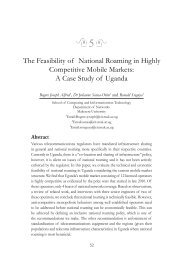Undergraduate Handbook - School of Computing and Informatics ...
Undergraduate Handbook - School of Computing and Informatics ...
Undergraduate Handbook - School of Computing and Informatics ...
You also want an ePaper? Increase the reach of your titles
YUMPU automatically turns print PDFs into web optimized ePapers that Google loves.
Reference Books:<br />
i. M. Hall, Core Servlets <strong>and</strong> Java Server Pages, Volume 1: Core Technologies, 2nd edition.<br />
BSE 2203: Computer Networks & Data Communication (4 CU)<br />
Course Description: Upon successful completion <strong>of</strong> this course students should be able to: Master the terminology<br />
<strong>and</strong> concepts <strong>of</strong> the OSI reference model <strong>and</strong> the TCP/IP reference model; Master the concepts <strong>of</strong> protocols,<br />
network interfaces, <strong>and</strong> design/performance issues in local area networks <strong>and</strong> wide area networks; Demonstrate<br />
knowledge <strong>of</strong> wireless networking concepts; Appreciate contemporary issues in networking technologies; <strong>and</strong><br />
demonstrate knowledge <strong>of</strong> network tools.<br />
Indicative Content: Introduction to Networks: definition, advantages, types, configurations; The OSI/ISO reference<br />
model; Transmission media: magnetic media, twisted pair, coaxial, fiber-optics; Data encoding: straight,<br />
Manchester, differential Manchester, satellite; Digital versus Analog transmission; Modems, modulation <strong>and</strong> their<br />
st<strong>and</strong>ards, codes <strong>and</strong> pulse code modulation; Integrated Services Digital Networks (ISDN); Network Access<br />
Protocols; Passive versus dynamic allocation; LAN st<strong>and</strong>ards:802.3 (Ethernet), 802.4 (token bus), 802.5 (token<br />
ring); Computer Network security, Active <strong>and</strong> Passive Attacks; Network layer <strong>and</strong> Network layer protocols;<br />
Transport layer <strong>and</strong> Transport layer protocols. Furthermore, the course considers problems on each layer <strong>of</strong> a<br />
multilayered communication model, <strong>and</strong> describes some typical solutions to such problems.<br />
Reference Books:<br />
i. J. F. Kurose <strong>and</strong> K. W. Ross, Computer Networking - A Top Down Approach Featuring the Internet, 3rd<br />
edition, Addison-Wesley.<br />
ii. L. Peterson <strong>and</strong> B. Davie, Computer Networks: A Systems Approach.<br />
BSE 2204: Modeling in Information Systems (4 CU)<br />
Course Description: Upon successful completion <strong>of</strong> the course, the student should: Be able to demonstrate<br />
sufficient underst<strong>and</strong>ing <strong>of</strong> the various modeling tools <strong>and</strong> techniques; Be able to model an information system<br />
using the Universal Modeling Language (UML); Be able to model business processes; Select a suitable modeling<br />
language based on the context; <strong>and</strong> be able to evaluate the quality <strong>of</strong> models using model checking tools <strong>and</strong> formal<br />
methods:<br />
Indicative Content: This course deals with methods <strong>and</strong> techniques used in systems analysis <strong>and</strong> design. This<br />
includes modeling the enterprise, application domains, business processes <strong>and</strong> activities, <strong>and</strong> information systems<br />
components. Main topics to be covered are: Modeling the enterprise: Object-oriented concepts, object-oriented<br />
enterprise modeling. Modeling the business process: process <strong>and</strong> workflow modeling, IDEF0, <strong>and</strong> SAP R/3 process<br />
models, Modeling the dynamics: Data flow diagram (DFD), structured English, decision table, decision tree, <strong>and</strong><br />
state-transition diagram. Modeling the structures: Entity-relationship (ER) models. Putting the designs together:<br />
Unified Modeling Language (UML) Evaluation <strong>of</strong> methods: Evaluation criteria.<br />
Reference Books:<br />
i. A. Olive, Conceptual Modeling <strong>of</strong> Information Systems, Springer, 1st edition, 2007.<br />
ii. R. A. Hirschheim, H. K. Klein <strong>and</strong> K. Lyytinen, Information Systems Development <strong>and</strong> Data Modeling:<br />
Conceptual <strong>and</strong> Philosophical Foundations, Cambridge University Press, 1995.<br />
BSE 2202: Embedded Systems S<strong>of</strong>tware (4 CU)<br />
Course Description: Upon successful completion <strong>of</strong> this course, the student will: Underst<strong>and</strong> the role <strong>of</strong> assembly<br />
language programming; Underst<strong>and</strong> the instruction set <strong>of</strong> a typical embedded processor (68HC11); Be able to<br />
employ a modular approach to assembly language programming with code reuse; Be able to use embedded systems<br />
development tools; Underst<strong>and</strong> memory addressing <strong>and</strong> use various addressing modes; Underst<strong>and</strong> hardware<br />
interrupts <strong>and</strong> be able to use them; <strong>and</strong> be able to integrate assembly language subroutines into a high-level language<br />
Programme.<br />
113

















